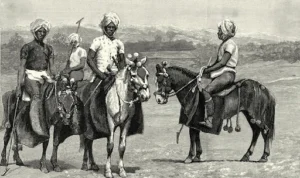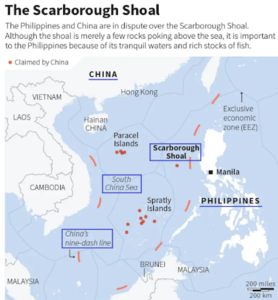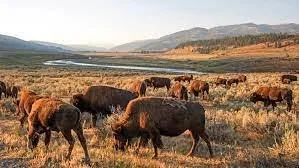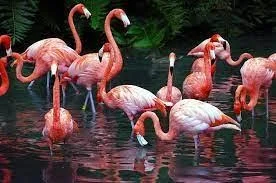UPSC GS 1
Lushai Tribe
- News: A rare hemi-parasitic terrestrial plant has been named ‘Phtheirospermum Lushaiorum’ after the Lushai tribe of Mizoram.
- Tribal Group: Lushai, commonly known as Mizos, are part of the Kuki-Chin group of tribes.
- Racial Origin: They are racially of Mongoloid origin.
- Main Occupations: Jhum cultivation (shifting agriculture) and Orange cultivation.
- Historical Aspect: Traditionally known as a Head Hunter community.
- Religion:
-
- Conversion to Christianity: In the first part of the 19th century, most Lushais converted to Christianity.
- Christianity remains their primary religion today.
-
- Cultural Significance
- Bamboo Dance: Their Bamboo Dance, known as Cheraw-dance, is very popular both within and outside the country.
- Family Structure:
-
- The basic unit of Lushai (Mizo) society is a patrilocal joint family.
- They follow patrilineal descent and inheritance rules.
-
- Phtheirospermum Lushaiorum:
-
- It is a rare hemi-parasitic terrestrial plant that has been found in Phawngpui National Park of Mizoram.
- Root System and Parasitic Nature:
- This plant lacks a fully developed root system.
- It taps into the sap of host plants through specialized structures known as haustoria.
- Photosynthesis and Independence:
- Despite being parasitic, it contains chlorophyll and can produce its food, showing some independence from its host.
- Growth and Reproduction
- Flowers from July to September.
- Produces fruit from August to October.
- Location: Grows near a popular trekking route in Phawngpui National Park.
- Threats: Faces threats from both human activities and natural factors.
-
- Phawngpui National Park: It is also known as Blue Mountain National Park.
-
- It is one of the two national parks in Mizoram (the other being Murlen National Park).
- Geographical Location: Close to the border with Burma (Myanmar)
- Landmarks: The park overlooks the Chhimtuipui River, which flows towards Burma.
- Distinctive Geography: Characterized by its cloud-covered mountain area, giving it a distinctive blue appearance from a distance
- Flora and Fauna
- Blyth’s tragopan
- Falcons
- Sunbirds
- Dark-rumped swifts
- Mizoram state bird, Mrs. Hume’s pheasant
- Mammals:
- Mountain goat
- Slow loris
- Tiger
- Leopard
- Leopard cat
- Serow
- Goral
- Asiatic black bear
- Stump-tailed macaque
- Capped langur
- Flora:
- Grassy meadows
- Orchids
- Rhododendrons
- Bamboo groves
-
Meitei Sagol
- News: The Government of Manipur has recently joined hands with various organisations and associations to save the Manipuri Pony or Meitei Sagol.
- Recognized Horse and Pony Breeds of India:
-
- Meitei Sagol is one of the seven recognized horse and pony breeds in India.
- Other breeds include: Marwari Horse, Kathiawari Horse, Zanskari Pony, Spiti Pony, Bhutia Pony, and Kachhi-Sindhi Horse.
-

- Etymology:
-
- “Meitei” refers to the Meitei people, an ethnic group indigenous to Manipur.
- “Sagol” means “horse” in the Meitei language.
-
- Physical Traits:.
-
- Short in height
- Renowned for stamina, agility, intelligence, speed, and adaptability to harsh environments.
-
- Cultural Significance:
-
- Contribution to Polo: Instrumental in the development of modern polo, originating from the traditional Manipuri sport “Sagol Kangjei.”
- Considered as the original polo pony.
-
- Ceremonial Importance:
-
- Featured prominently in ceremonies like Lai Haraoba, a religious festival in Manipur.
-
- Threats: The Manipur government declared the Manipuri Pony as an Endangered Breed in 2013.
-
- Shrinkage of wetlands
- Lack of polo grounds/polo playing areas in rural Manipur;
- Restriction of pony usage except in the game of polo;
- Uncontrolled diseases;
- Exodus of ponies to neighbouring states and countries
-
Scarborough Shoal
- News: The Philippines challenged China recently to open Scarborough Shoal to international scrutiny after it accused Beijing of destroying the shoal’s marine environment.
- Overview of Scarborough Shoal
- Location:
-
- The Scarborough Shoal (also known in English as the Scarborough Reef) is a series of small rocks and islands which are formed into a triangle shape in the South China Sea.
- It is also known as Huangyan Island (Chinese name) or Panatag Shoal (Philippine name).
- It is approximately 230 km (130 nautical miles) west of the Philippine island of Luzon.
- It is about 650 km southeast of China’s Hainan Island.
- It is a disputed territory in the South China Sea.
-

- Claims:
-
- China: Claims historical ownership tracing back to the Yuan Dynasty of the 1200s and includes it within its “nine-dash” line.
- Philippines: Claims based on proximity, as it is much closer to their shores.
-
- Strategic Importance
-
- It is rich in fishing resources.
- Located along important shipping lanes in the South China Sea.
- Scarborough Shoal features a lagoon that contains many commercially valuable shellfish and sea cucumbers.
- Control over the shoal provides exclusive economic rights over the surrounding waters and potential oil and gas resources.
- The rocks and islands provide a form of natural shelter which can be used by fishermen during rough seas.
-
What is a Lagoon?
|
- Current Status:
-
- In June 2012, China gained effective control over the area after the Philippines withdrew its ships due to bad weather.
- China has maintained a presence there since then, denying access to Philippine fishing vessels.
-
UPSC GS 2
Furlough
- News: This term has been in the news.
- Definition: In the Indian legal context, furlough refers to a conditional release granted to a prisoner serving a long-term sentence.
- Legality: In India, parole (as well as furlough) are covered under The Prisons Act of 1894. Prisoners convicted of multiple murders or under the anti-terror Unlawful Activities Prevention Act (UAPA) are not eligible for parole.
What is Parole?
|
- Purpose: Furlough aims to break the monotony of imprisonment, allows the prisoner to maintain family and social ties, and facilitate reintegration into society.
- Legal Status: It’s considered a substantial legal right, but not an absolute right. Prisoners can’t necessarily demand it, but authorities can’t deny it arbitrarily if permitted by law.
- State-Specific Rules: Since prison is a State subject in the Constitution, every State has formulated its own set of rules/guidelines for getting furlough and parole.
- Key Differences from Parole:
-
- Reason: Furlough is granted periodically without a specific reason, while parole requires a specific reason like a family emergency.
- Sentence Impact: The time spent on furlough is considered remission of the sentence, effectively reducing the total time served. Time spent on parole isn’t deducted from the sentence.
- Duration: Furlough typically lasts a maximum of 14 days, while parole can be for a month or longer.
- Parole can be granted number of times whereas there is a limitation in the case of furlough.
- Grant: Parole is granted by Divisional Commissioner and furlough is granted by the Deputy Inspector of General of Prisons.
- Denial: Parole can be denied even when the prisoner makes out a sufficient case, if the competent authority is satisfied that releasing the convict would not be in the interest of society.
- Furlough can also be denied in the interest of society because it is not granted for any specific reason.
-
UPSC GS 3
Rangelands
- News: A new report from the United Nations Convention on Combating Desertification (UNCCD) highlights that approximately half of the world’s rangelands are degraded and require policy interventions.

- Rangelands:
-
- As per the UNCCD report, rangelands are natural or semi-natural ecosystems that are grazed by livestock or wild animals.
-
- Vegetation:
-
- Rangelands contain vegetation such as grasses, shrubs, bushes, open forests, and agroforestry systems (land which contains trees and crops or pastures).
-
- Influence of Climate:
-
- The exact nature of rangelands’ vegetation is influenced by rainfall, temperature, and other climate phenomena.
-
- Global Coverage:
-
- Currently, rangelands cover 80 million sq km of Earth’s terrestrial surface area (over half of Earth’s land), and are thus the largest land cover or land use type in the world.
- In India, rangelands occupy about 1.21 million sq km, from the Thar Desert to Himalayan meadows.
-
- Importance of Rangelands:
-
- Act as carbon sinks, absorbing more carbon from the atmosphere than they release.
- Serve as storage areas for freshwater.
- Help prevent desertification of land.
- Millions of people worldwide rely on rangelands for food security and livelihoods.
- Rangelands generate 16% of global food production and 70% of feed for domesticated herbivores, most significantly in Africa and South America.
-
- Key Findings of Report:
-
- Degraded Rangelands: Nearly 50% of the world’s rangelands are classified as “degraded,” facing a concerning decline.
- Primary Drivers: Climate change, unsustainable land and livestock management practices, biodiversity loss, and conversion of rangelands to farmlands are key factors driving rangeland degradation.
- Impact on Communities: Uncertainty over land rights among pastoralist communities exacerbates rangeland degradation.
- Deterioration of rangelands adversely affects soil fertility and biodiversity, leading to reduced incomes and increased conflicts with authorities over grazing rights.
-
Critical Tiger Habitat (CTH)
- News: Recently, the Supreme Court directed the Rajasthan government to close 68 mines that are operating within a 1-kilometer radius of the critical tiger habitat (CTH) of the Sariska reserve.
- About Critical Tiger Habitat (CTH):
-
- CTHs are designated areas within National Parks and Sanctuaries deemed necessary to remain ‘inviolate’ for wildlife conservation.
- ‘Inviolate’ is a general term used to indicate no human settlement and usage.
- They are also known as the core areas of tiger reserves and are designated under the Wild Life Protection Act (WLPA) of 1972.
-
- Conservation Aim:
-
- These areas are scientifically identified to be maintained as inviolate zones for tiger conservation, ensuring that the rights of the Scheduled Tribes and other forest dwellers are not affected.
-
- Components within a Tiger Reserve:
-
- Core or Critical Tiger Habitat: This area has National Park or Sanctuary status and is essential for the survival of tigers.
- Buffer or Peripheral Area: Surrounds the core habitat and provides additional support for tiger conservation.
- Rights Protection: The core habitat is specifically designated to ensure the long-term viability of tiger populations without compromising the rights of Scheduled Tribes or other forest dwellers.
- Territorial Nature: Tigers are territorial animals, so their core habitat is distinct from the broader “critical wildlife habitat” applicable to other wild species.
-
- Criteria for CTH:
-
- Scientific Identification: Identifying CTH by establishing on the basis of scientific and objective area without affecting the rights of the Scheduled Tribes or other forest dwellers.
- Rights Settlement: Establishing CTH through voluntary relocation on mutually agreed terms as provided that such terms and conditions satisfy the requirements laid down in WLPA, 1972.
- It must be noted that no Scheduled Tribes or other forest dwellers shall be resettled for the purpose of CTH unless the process of recognition and determination of rights of the Scheduled Tribes and such other forest dwelling persons is complete.
- Consultation and Consent Process: The notification of CTH is done by the state government in consultation with the expert committee constituted for the purpose.
-
- What are Critical ‘wildlife’ habitats (CWLHs)?
-
- Critical ‘wildlife’ habitats (CWLHs) are defined only in the Forest Rights Act, 2006.
- CWLHs are meant to be areas of national parks and wildlife sanctuaries that are required to be kept as inviolate for the purpose of wildlife conservation (not just tigers).
- Similar to CTH, the identification of CWLH is done based on scientific and objective criteria, but it mandatorily requires settlement of forest rights under FRA.
- Unlike CTHs, the notification of CWLHs can only be done with the consent of the Gram Sabhas and affected stakeholders.
- Post notification, the forest rights in CWLHs can be modified or resettled subject to certain conditions.
-
- Sariska Tiger Reserve:
-
- Sariska National Park is situated in Alwar (Rajasthan).
- History: It was once a hunting ground of the Maharaja of Alwar before being proclaimed a natural reserve in 1955 & national park in 1979.
- Terrain: It has rocky landscapes. The Ruparel River flows through the Sariska Tiger Reserve in Rajasthan, India.
- Flora: Crub thorn arid forests, grasses, hilly cliffs & semi deciduous wood. Several trees like Dhok, Tendu & Khair are also found in its forests.
- Faunas: Royal Bengal Tiger, jungle cats, rhesus macaque, sambhar, chital, wild boar.
-
Flamingos
- News: 40 flamingos were found dead in Mumbai after being hit by an aircraft.
- Flamingos (Phoenicopterus roseus): These are birds renowned for their bright pink feathers, stilt-like legs, S-shaped neck, and distinctive downward-bending beak adapted for filter-feeding.
- Species: The six flamingo species are the greater flamingo, Chilean flamingo, American flamingo, lesser flamingo, Andean flamingo and James’s flamingo.
-
- The lesser flamingo is the smallest species of flamingo, though it is a tall and large bird by most standards.
-
- Diet: Omnivore
- Distribution: Flamingos are found in parts of Africa, the Americas, Europe, and Asia, typically in large alkaline or saline lakes and estuarine lagoons.

- Features:
-
- Their unique pink or reddish color comes from the carotenoid pigments found in the algae, shrimp, and other small organisms that they eat.
- They are able to “run” on water, thanks to their webbed feet, to gain speed before lifting up into the sky.
- Flamingos are filter feeders, using their specialized curved beaks to strain out small organisms from the water.
- They are highly social birds and often live in large colonies.
-
- IUCN Status: While most flamingos aren’t endangered, the Andean flamingo is listed as Vulnerable and the Chilean, lesser and James’s flamingos are listed as Near Threatened by the IUCN Red List of Threatened Species.
Read also: Key Events, Initiatives, and Movements Against British Rule in India
Genetic Drift (GD)
- News: Genetic drift, not natural selection has been identified as the main factor driving speciation in endangered pupfish species.
- Definition: Genetic drift is the idea that the frequency of alleles (different versions of a gene) in a population can change due to random chance, not because of any advantage the allele provides.
- Genes and Alleles:
-
- A gene is the basic physical and functional unit of heredity. Genes are made up of DNA. A gene contains instructions for a particular trait.
- Alleles are the variations in those instructions.
- Example: A gene for eye color might have a brown allele or a blue allele, each coding for the trait slightly differently.
-
- Allele Frequency:
-
- Frequency of alleles refers to how common a particular allele is within a population.
- Example: The brown eye color allele might represent 65% of the total population.
- This frequency can change randomly, as explained by genetic drift.
-
Pupfish Species
|
- Genetic Drift vs. Natural Selection:
-
- Genetic drift is a random process.
- Natural selection favors alleles that provide a survival or reproduction advantage.
- Unlike natural selection, genetic drift does not act on beneficial traits.
-
- Impact on Small Populations:
-
- Genetic drift has a stronger effect in smaller populations.
- With fewer individuals, the chance of an allele being passed on just by luck becomes more significant.
-
- Loss of Genetic Variation:
-
- Over time, genetic drift can lead to a loss of genetic variation.
- Alleles can become fixed (everyone has that version) or disappear entirely.
-
- Role in Evolution:
-
- Although random, genetic drift can significantly influence evolution, especially in small populations.
-
- Types of GD:
-
- Bottleneck Effect: Pandemic like flu, severe acute respiratory syndromes, human immunodeficiency virus, COVID-19, natural etc reduce to the effective size of the population and change genetic diversity.
- Effective size of a population refers to those interbreeding individuals who by mating contribute offspring to next generation.
- As a result of reduction in effective size of population, the allele frequency will be different before the action of genetic drift which resembles the neck of the bottle restricting the flow of genes.
- Therefore, this is called bottle neck effect.
- Bottle neck effect reduces the genetic diversity and change the allele frequency.
- Founder Effect: Founders are early settlers or ancestors who established new colony or population in foreign lands.
- The founding of new colony or subpopulation may also take place due to exploration of island or new area, warfare, survival from ship wreck, repeated migration from their lands to new landscapes.
- The founders of subpopulation carry random sample of genes.
- The new subpopulation after a few generations may be characterised by the absence of alleles or higher prevalence of rare alleles against the larger population.
- Repeated migrations of humans during different time periods establish new subpopulation whose genetic composition will be different from the original population. This is called serial founder effect.
-
Small Industries Development Bank of India (SIDBI)
- News: Airbus Helicopters and Small Industries Development Bank of India (SIDBI) have signed a memorandum of understanding (MoU) for financing the purchase of the company’s helicopters in India.
- Establishment: SIDBI was established under an Act of Parliament in 1990.
- Jurisdiction: Operates under the Ministry of Finance.
- Primary Mission: Facilitate the growth and development of Micro, Small, and Medium Enterprises (MSMEs) through:
-
- Financial Support: Primarily through wholesale lending to intermediaries.
- Non-Financial Support: Includes advisory services, training programs, and technical assistance.
-
- Ownership: SIDBI is owned by the Government of India.
- Shareholding:: The majority of its shares are held by various public sector banks, insurance companies, and financial institutions.
- Headquarters: Located in Lucknow, Uttar Pradesh.
R21/Matrix-M vaccine
- News: India’s Serum Institute ships first batch of R21 malaria vaccine to Africa.
- New Malaria Vaccine: R21/Matrix-M vaccine is a new vaccine has been approved for the prevention of malaria in children.
- Development: Developed by the University of Oxford and the Serum Institute of India.
-
- Supported by the European and Developing Countries Clinical Trials Partnership (EDCTP), the Wellcome Trust, and the European Investment Bank (EIB).
-
- Efficacy: It is the first malaria vaccine to achieve the WHO’s target of 75% efficacy.
- Target: The R21/Matrix-M vaccine targets the Plasmodium sporozoite, the initial form of the malaria parasite that enters the human body.
- Vaccine Type: R21 is a subunit vaccine that delivers parts of a protein secreted by the sporozoite to trigger an immune system response.
- About Malaria
- Cause: Malaria is an infectious disease caused by parasites of the Plasmodium genus.
-
- Transmitted primarily to humans through the bite of infected female Anopheles mosquitoes.
-
- Infection Process: Once infected, the parasites multiply in the liver and then infect red blood cells, causing a range of symptoms.
- Symptoms:
-
- High fever
- Chills
- Sweats
- Headache
- Muscle aches
- Fatigue
- Nausea
- Vomiting
- Severe cases can lead to anemia, organ failure, and death.
-
- Geographical Distribution:
-
- Most common in tropical and subtropical regions.
- Sub-Saharan Africa has the highest burden of malaria cases and deaths.
-
- Preventive Measures:
-
- Use of insecticide-treated bed nets
- Indoor residual spraying
- Antimalarial drugs (chloroquine, hydroxychloroquine, primaquine, atovaquone).
-
New Shepard -25 (NS-25) Mission
- News: Blue Origin’s NS25 completed its 25th flight, marking its seventh human spaceflight.
- Historic Achievement: Gopichand Thotakura becomes the first Indian space tourist.
-
- He was one of six crew members selected for the sub-orbital space flight of Blue Origin’s NS-25 Mission.
-
- NS-25 Mission
-
- Rocket System: NS-25 is a rocket system designed by Blue Origin, a US private space company.
- It is intended to take astronauts and research payloads past the Karman line.
-
- Karman Line:
-
- Lies nearly 100 kilometers above sea level.
- It is the internationally recognized boundary of space.
-
- Blue Origin’s Milestone: NS-25 was Blue Origin’s seventh human spaceflight mission.
RBI’s Proposed Framework To Administer Project Financing
- News: To strengthen the rules for long-term financing of infrastructure, non-infrastructure, and commercial real estate projects, the RBI has released draft regulations for consultation.
- Context: The Reserve Bank of India (RBI) has issued draft regulations to improve the regulatory framework for financing long-term projects in the infrastructure, non-infrastructure, and commercial real estate sectors.
- Purpose of the Framework:
-
- To manage the high financial risks linked to infrastructure projects.
- These projects often face long delays and cost overruns due to challenges like land acquisition and regulatory clearances.
-
- Key Revisions Proposed:
-
- Increased Provisioning: General provisioning for potential losses during the construction phase to be raised from 0.4% to 5%, gradually implemented.
- Focus Areas: Emphasis on avoiding defaults or delays in the Date of Commencement of Commercial Operations (DCCO) and managing reductions in the Net Present Value (NPV) of projects.
- Prerequisite Compliance: All critical requirements like environmental, regulatory, and legal clearances must be met before financial closure.
- Project Monitoring: Continuous monitoring and independent certification of project progress.
- NPV Mandate: Projects must have a positive NPV initially and undergo annual re-evaluation to prevent stress buildup and ensure proactive management.
- Repayment Schedule Limitation: Original or revised repayment schedules, including any moratorium period, should not exceed 85% of the project’s economic life.
- Standby Credit Facility: Introduction of guidelines for a standby credit facility sanctioned at the time of financial closure to address potential overruns due to project delays.
- DCCO: The DCCO should be clearly defined, and financial disbursements should align with the stages of project completion.
-
- Potential Impact: The increased provisioning requirement may affect the short-term profitability of non-banking financial companies and infrastructure financiers.
Copernicus Emergency Management Service
- News: After a helicopter crash in East Azerbaijan province involving Iranian President Ebrahim Raisi, the European Union activated its Copernicus EMS rapid response mapping service. This was done in response to a request from Iran, marking a collaborative effort between the two entities.
- Overview of Copernicus EMS Programme:
- Origins: Originally launched as the Global Monitoring for Environment and Security Programme (GMES) in 1998.
- Data Sources: Utilizes a wide range of data sources, including satellites, terrestrial, airborne, and maritime measurement systems.
- Purpose: Offers environmental information beneficial for researchers, policymakers, public authorities, international organizations, and commercial/private users.
- Applications: Supports various applications, including climate change response, disaster management, and agriculture.
- Components:
-
- Space Component: Consists of a constellation of satellites known as the Sentinels and Contributing Missions.
- Ground Component: Involves in-situ sensors facilitating access to data from the Sentinels and Contributing Missions.
-
- There are two components of Copernicus Emergency Management Service: the mapping component and the early warning component.
-
- Mapping Component: Provides maps and analysis based on satellite imagery.
- Rapid Mapping (RM): Offers maps within days or hours, globally. Activated for immediate responses, such as locating Raisi’s crashed helicopter.
- To provide maps quickly, the service acquires, processes, and analyses satellite imagery, geospatial data, and social media when required.
- The RM service can supply four different “products” — each one of them provides maps and brief analysis — which the user can choose while requesting the service.
- Risk and Recovery Mapping (RRM): Delivers maps for disaster management within weeks or months. Used for prevention, preparedness, disaster risk reduction, and recovery.
- Mapping Component: Provides maps and analysis based on satellite imagery.
-
- Early Warning Component: Issues alerts for floods, droughts, and forest fires. Provides near-real-time assessment of forest fire impacts.
Psychedelics
- News: Professors at Mumbai’s Tata Institute of Fundamental Research have discussed the use of controversial substances known as psychedelics, which belong to a class of hallucinogens.
- Definition: Psychedelics are drugs that change perception, behavior, consciousness, and thought, often heightening sensory awareness.
- Types of Psychedelics:
-
- Classical Psychedelics: These drugs primarily cause hallucinations by activating serotonin 5-HT receptors found throughout the body.
- Examples include LSD, psilocybin, and DMT.
- Non-Classical Psychedelics:
- These substances interact with various receptors.
- Notable examples are ketamine and MDMA.
-
- Mechanism of Action: Most psychedelics increase serotonin levels, a mood-stabilizing hormone, by binding to serotonin receptors on cell surfaces.
- Research and Clinical Use: Five psychedelics are extensively studied for treating mental health issues: psilocybin, LSD, MDMA, ketamine, and DMT.
- Regulation:
-
- The UN Convention on Psychotropic Substances 1971 convention regulates around 200 psychotropic substances across four schedules.
- Schedule I lists substances with the highest potential for abuse but does not specify the count or types of substances classified as psychedelics.
-

